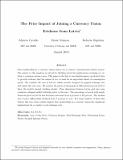The Price Impact of Joining a Currency Union: Evidence from Latvia
Author(s)
Neiman, Brent; Rigobon, Roberto; Cavallo, Alberto F.
DownloadCNR_Latvia.pdf (247.1Kb)
OPEN_ACCESS_POLICY
Open Access Policy
Creative Commons Attribution-Noncommercial-Share Alike
Terms of use
Metadata
Show full item recordAbstract
Does membership in a currency union matter for a country’s international relative prices? The answer to this question is critical for thinking about the implications of joining (or exiting) a common currency area. This paper is the first to use high-frequency good-level data to provide evidence that the answer is yes, at least for an important subset of consumption goods. It considers the case of Latvia, which recently dropped its pegged exchange rate and joined the euro zone. The paper analyzes the prices of thousands of differentiated goods sold by Zara, the world’s largest clothing retailer. Price dispersion between Latvia and euro zone countries collapsed swiftly following entry to the euro. The percentage of goods with nearly identical prices in Latvia and Germany increased from 6 to 89 percent. The median size of price differentials declined from 7 percent to zero. If a large number of firms also behave this way, these results suggest that membership in a currency union has significant implications for a country’s real exchange rate.
Date issued
2015-07Department
Sloan School of ManagementJournal
IMF Economic Review
Publisher
Palgrave Macmillan Publishers
Citation
Cavallo, Alberto, Brent Neiman, and Roberto Rigobon. “The Price Impact of Joining a Currency Union: Evidence from Latvia.” IMF Econ Rev 63, no. 2 (July 14, 2015): 281–297.
Version: Author's final manuscript
ISSN
2041-4161
2041-417X